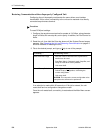
8. Troubleshooting
8-10
September 2002 9128-A2-GB20-80
LOS at DSX-1 A Loss of Signal (LOS)
condition is detected on the
DSX-1 interface. Clears
when the ratio of ones to
zeros received is greater
than or equal to 12.5%.
DSX-1 cable problem.
No signal being
transmitted from the
DTE.
Check that the DSX-1 cable is
securely attached at both ends.
Check the DTE status.
LOS at Network
1 A Loss of Signal (LOS)
condition is detected on the
network interface. Clears
when the ratio of ones to
zeros received is greater
than or equal to 12.5%.
Network cable problem.
No signal is being
transmitted at the far-end
FrameSaver unit.
T1 facility problem.
Check that the network cable is
securely attached at both ends.
Check far-end FrameSaver unit
status.
Contact your network provider.
Network Com Link
Down
The communication link for
the COM port is down and
the COM port is configured
for Net Link.
Check the router connected to the
COM port.
OOF at DSX-1 An Out of Frame (OOF)
condition is detected on the
DSX-1 interface.
Incompatible framing
format between the DTE
and the FrameSaver
unit.
DSX-1 cabling problem.
Check that the framing format
for the DSX-1 (DTE) interface
is correct.
Check that the DSX-1 cable is
securely attached at both ends.
Table 8-1. Alarm Conditions (4 of 7)
Alarm Condition What It Indicates What To Do
1
nnnn
indicates a DLCI number of 16 through 1007.
2
frame relay link
is one of the following:
– Net1-FR1. The frame relay link specified for the network interface, Network 1.
– Port-
n
. The frame relay link associated with a user data port.
–
ISDN Link Name
on a non-network ISDN DBM interface.
3
Does not apply to a TS Access Management Link DLCI.


















